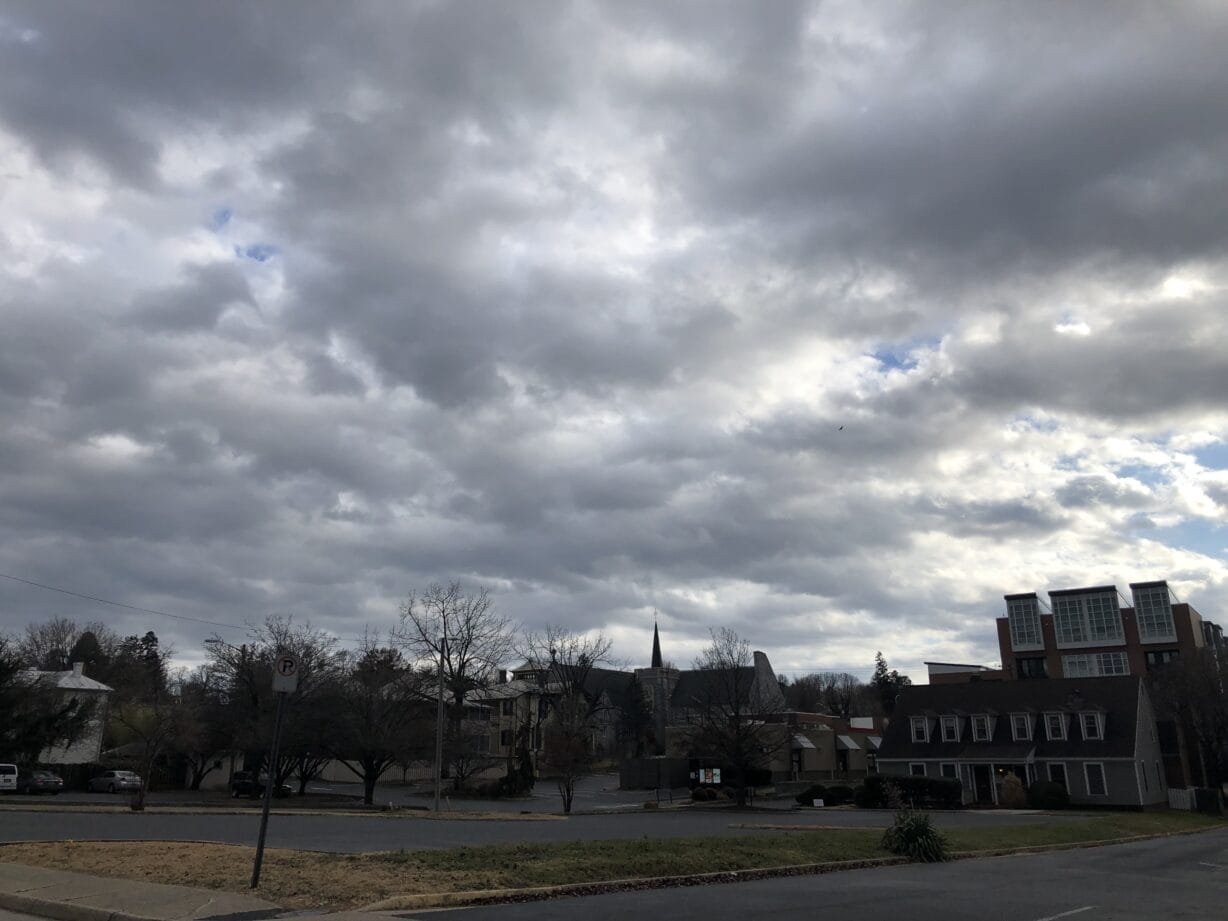
By Sofia Samatar
“The Friendly City” is a weekly column about walking in Harrisonburg that will run during 2024. Each week, your friendly correspondent, writer and teacher Sofia Samatar, will reflect on a walk in our city.
“How beautiful a street is in winter!” wrote Virginia Woolf. “It is at once revealed and obscured.” She wrote in the great city of London, where she had gone out on a winter’s evening to buy a pencil; we write in the little Friendly City, where we are going to the co-op to buy some chocolate-covered almonds for a party.
At once the comparison feels presumptuous. We are not Virginia Woolf, and the Friendly City, when called upon to stand in for the foreign metropolis, shivers from Park View to Sentara, ducks its head in an agony of bashfulness, and threatens to gather up its streets and retreat from view. But as we set out on a December afternoon, wrapped up against the chill that has settled down over the rooftops, we find that our city, like that of another writer in another country almost a hundred years ago, is revealed and obscured, exposed by the leafless branches and dimmed by the cloudy sky, swept clean by the wind and blurred by the tear sparked in our eye by a freezing gust.
There is something inspiring about the first real breath of cold. We had almost forgotten that our city could produce this weather. The buffeting wind calls up a spirit of adventure, rousing us to prolong our walk, to stride up Elizabeth Street and see how the old houses look in the slant of the winter light, to climb as high as we can, past Hill Street, up to the very edge of town, where the line of pine trees borders the cemetery. Here we can gaze down over the town, which appears to be half sky. A white sheet of cloud is pulled down over most of this sky, like a blind in a window; beneath it, a band of airy blue breathes over the deep blue wave of the mountains; beneath the mountains lie the sloping streets of the town.
Reflecting on Virginia Woolf’s essay about haunting the streets of London, we recall that while she writes wonderfully about houses, squares, shops, and people, there is very little in her record about the sky. But in the Friendly City, the sky is always one’s companion. At times it shrinks, when one descends into a valley between hills, but it’s always ready to spring up again, expanding, when one reaches the top of some elevation, into a backlit, ever-shifting panorama of color and form. Even now the sky is changing. The wall of mist breaks up and darkens; separate clouds take shape, almost black in the center but ringed with silver; creamy folds sink down against the mountains, so thick the light can only come through sluggishly, giving them a faint gloss like the sheen on marble. A hard sky, gleaming like milky glass, dense and sculpted like ice. At this height, we belong to the sky more than the city, which looks like a toy town, the streets laid out under our eye as if on a living-room carpet, lined with miniature houses, furnished with a wee factory tower and topped with the steeple of a pocket-sized church.
We wonder if it will ever be possible to feel immersed in the Friendly City, plunged into an extensive urban mass. Even if the city sprawls to huge proportions, it will have these hills. Will it always have this aspect of a toy town, then? Will it always feel, in some way, small?
As we walk back downhill, the splendid view of the mountains sheds its mulberry-colored glow over the weatherbeaten houses, the shabby cars, the unkempt yards full of children’s bicycles flung down at random, basketballs, rakes, discarded furniture, and forgotten shoes. Dogs bark wildly behind the walls. There’s a palpable sense of life—jumpy, busy, haphazard, vulnerable—going on all over the street. How amazing it is to find so much vibrant, disorganized life at this height, against such a view! In many places, such vistas belong only to the rich; hotels command them; pristine, soundproof condominiums claim the most beautiful situations. But here, school buses still trundle up and down the steep incline, and children disembark, yelling, dressed in hand-me-downs, waving the crumpled paper snowflakes they made at school, which will be pasted up in the dusty windows that look out on the blue flanks of the mountains and the inexhaustible glory of the sky. Ordinary people enjoy this vision every day. As we pass a peeling house whose sagging steps have been propped up here and there with bricks, a diminutive elderly man emerges with an enormous dog that, startled by our presence, goes for us with a vehement howl. The old man just manages to restrain his companion. For a long time, as we continue walking briskly down the sidewalk, we can hear him cursing in a squeaky voice while the animal, still barking ferociously, bounds all over the place, in the street, in the neighbor’s yards, dragging him behind it. We can’t help laughing. In the deepening twilight, lamplit windows have begun peeping through the overgrown shrubbery, and strings of holiday lights twinkle along the porches. Dear little street, may you always stay this way, untrimmed and flickering, with your loose boards, pestering children, and uncouth pets.
Here is the co-op, warm and bright. The chocolate-covered almonds, shiny as beads, tumble into our paper bag. Here is our own street, mantled with clouds, where golden garlands of festive lights cluster, winking in the wind. We remember beginning our notes on the Friendly City, almost a year ago. It was winter then, too, and the streets were revealed and obscured, like now, and thinking of this, we realize how the experiences of both walking and writing—whether in a large city or a small one—depend on the habit of attention. A street can’t be revealed in an abstract sense; it can only be revealed to someone. Revelation implies relationship. Somebody has to notice. And the strange thing about the habit of attention is that it transforms the practitioner internally, as if the act of seeing works on the unseen part of oneself.
Big town or small town, mountains or flatland, boulevard or sky? In the end, a concentrated focus on perceiving things, and attempting to describe one’s perceptions as accurately as possible, divulges a secret: the things seen are less important than the seeing eye. Having haunted the streets of the Friendly City so diligently during these months, we feel capable of haunting any street in the world.












